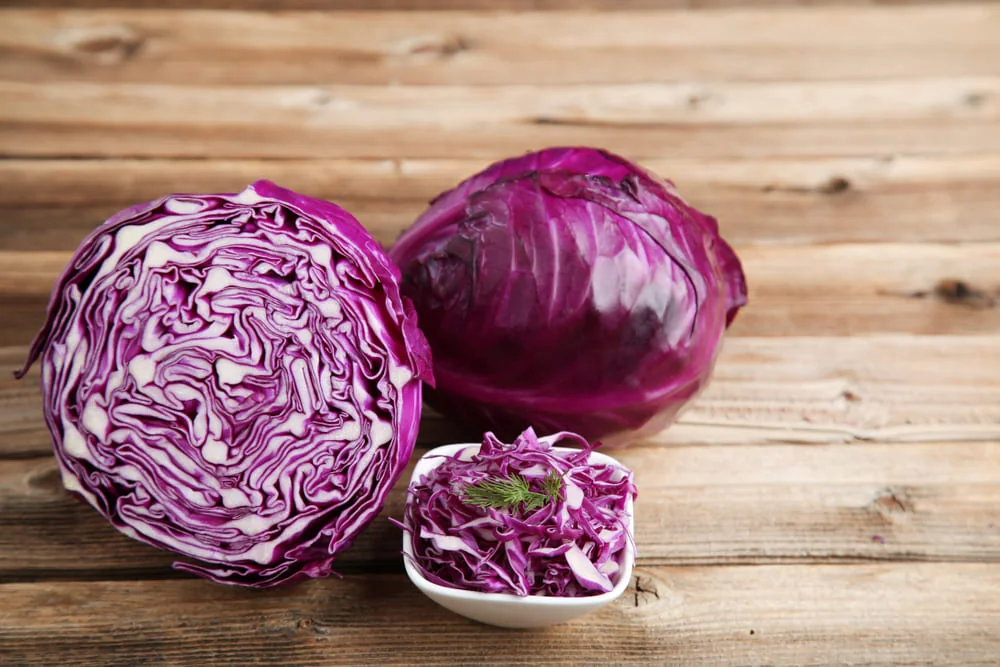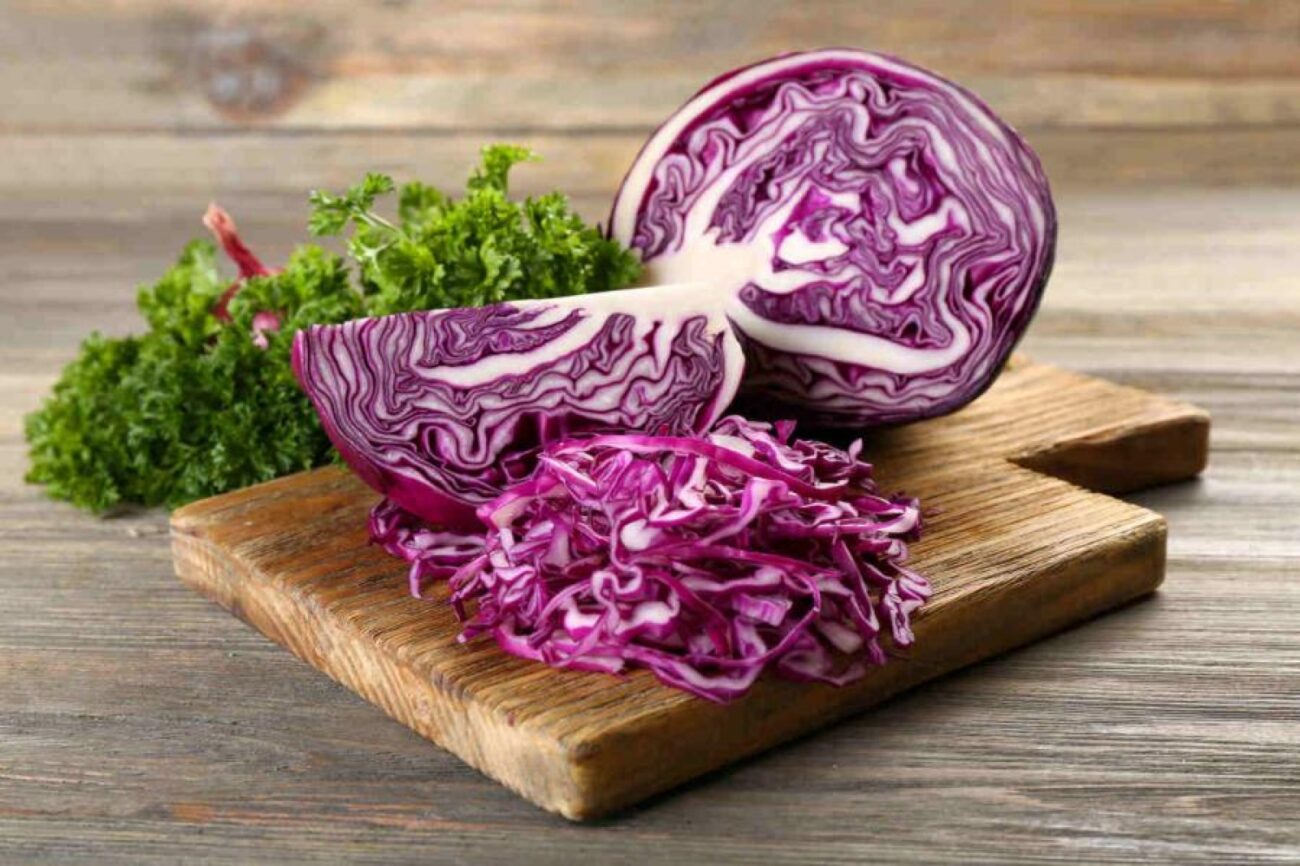Red cabbage, with its deep purple hue and crisp texture, is more than just a colorful addition to your plate. This cruciferous vegetable is a nutritional powerhouse, packed with vitamins, minerals, and antioxidants that offer a wide range of health benefits.
In this blog post, we’ll explore the benefits of red cabbage, how to incorporate it into your diet, and any potential contraindications to keep in mind.
What is Red Cabbage?
Red cabbage, also known as purple cabbage, is a member of the Brassica family, which includes other nutrient-dense vegetables like broccoli, kale, and Brussels sprouts. Its vibrant color comes from anthocyanins, a type of antioxidant that has been linked to numerous health benefits. Red cabbage is versatile, affordable, and can be enjoyed raw, cooked, or fermented (as in sauerkraut or kimchi).
Benefits of Red Cabbage
- Rich in Antioxidants
Red cabbage is loaded with antioxidants, including anthocyanins and vitamin C, which help combat oxidative stress and reduce inflammation in the body. These compounds may lower the risk of chronic diseases like heart disease and cancer. - Supports Heart Health
The fiber, potassium, and anthocyanins in red cabbage contribute to heart health by reducing cholesterol levels, improving blood pressure, and supporting healthy blood vessels. - Boosts Immunity
With a high vitamin C content, red cabbage strengthens the immune system, helping the body fight off infections and recover faster from illnesses. - Promotes Digestive Health
Red cabbage is an excellent source of dietary fiber, which supports healthy digestion, prevents constipation, and promotes a balanced gut microbiome. - Anti-Cancer Properties
Cruciferous vegetables like red cabbage contain glucosinolates, compounds that have been shown to have anti-cancer effects by detoxifying harmful substances and inhibiting tumor growth. - Supports Bone Health
Red cabbage is a good source of vitamin K and calcium, both of which are essential for maintaining strong and healthy bones. - Aids in Weight Management
Low in calories and high in fiber, red cabbage is a great addition to a weight-loss diet. It helps you feel full longer, reducing the likelihood of overeating. - Improves Skin Health
The antioxidants and vitamins in red cabbage promote healthy skin by reducing inflammation, fighting free radicals, and supporting collagen production.
How to Incorporate Red Cabbage into Your Diet
Red cabbage is incredibly versatile and can be enjoyed in a variety of ways. Here are some ideas:
- Raw in Salads:
Shred red cabbage and add it to salads for a crunchy, colorful boost. Pair it with carrots, apples, and a tangy vinaigrette for a refreshing dish. - Fermented as Sauerkraut or Kimchi:
Fermenting red cabbage enhances its probiotic content, making it great for gut health. Try making homemade sauerkraut or kimchi. - Cooked in Stir-Fries or Soups:
Add chopped red cabbage to stir-fries, soups, or stews for extra texture and nutrients. - Roasted or Grilled:
Toss red cabbage wedges with olive oil, salt, and pepper, then roast or grill them for a delicious side dish. - Blended into Smoothies:
For a nutrient-packed smoothie, blend a small amount of red cabbage with fruits like berries, bananas, and a splash of almond milk. - As a Wrap or Taco Shell:
Use large red cabbage leaves as a low-carb alternative to tortillas or wraps.
Contraindications and Precautions
While red cabbage is generally safe and beneficial for most people, there are a few considerations to keep in mind:
- Thyroid Conditions:
Red cabbage, like other cruciferous vegetables, contains goitrogens, which may interfere with thyroid function when consumed in large amounts. Individuals with hypothyroidism or iodine deficiency should consume it in moderation and consult their healthcare provider. - Digestive Sensitivity:
The high fiber content in red cabbage may cause bloating or gas in some individuals, especially if eaten raw. Cooking it can make it easier to digest. - Blood Thinners:
Red cabbage is high in vitamin K, which plays a role in blood clotting. People taking blood-thinning medications (like warfarin) should maintain a consistent intake of vitamin K-rich foods and consult their doctor. - Allergies:
Although rare, some people may have an allergy to cruciferous vegetables. If you experience symptoms like itching, swelling, or difficulty breathing after eating red cabbage, seek medical attention. - Kidney Stones:
Red cabbage contains oxalates, which may contribute to kidney stone formation in susceptible individuals. If you have a history of kidney stones, consume it in moderation.

Red cabbage is a vibrant, nutrient-dense vegetable that offers a wide range of health benefits, from boosting immunity to supporting heart and digestive health. Its versatility makes it easy to incorporate into your diet, whether raw, cooked, or fermented. However, as with any food, it’s important to be mindful of potential contraindications, especially if you have specific health conditions.
Have you tried adding red cabbage to your meals?
Share your favorite recipes or tips in the comments below!
Disclaimer: This blog post is for informational purposes only and is not a substitute for professional medical advice. Always consult a healthcare provider before making significant changes to your diet, especially if you have underlying health conditions.

